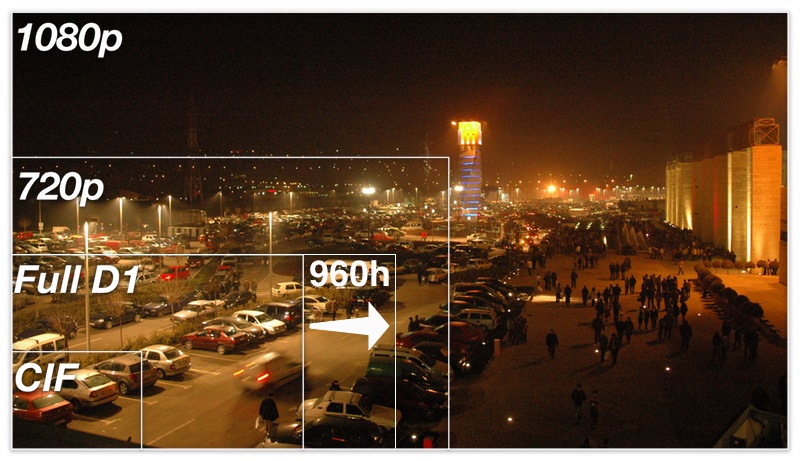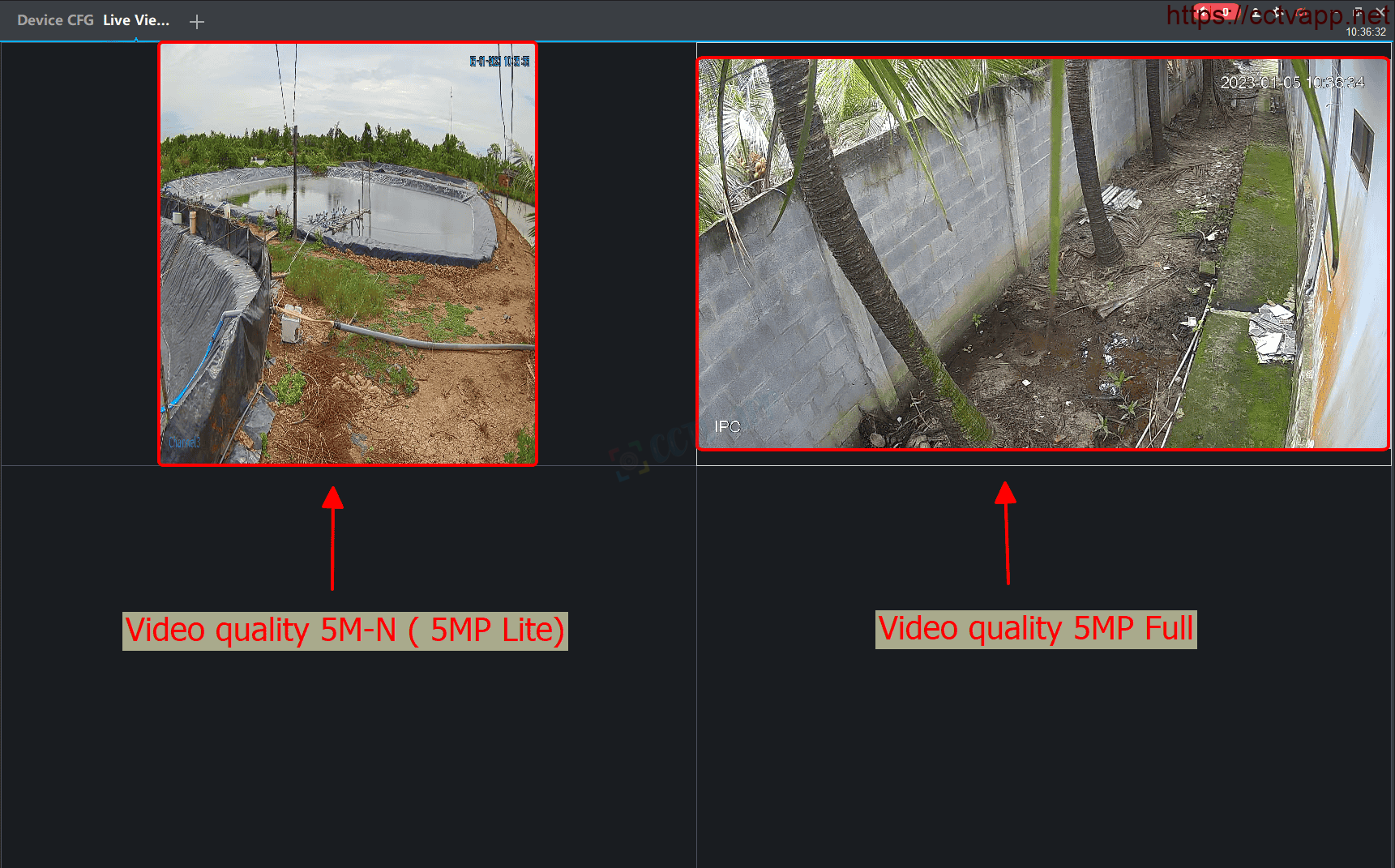Difference and comparison of video surveillance resolution standards CIF / D1 / 960H / 720p / 1080p.


One of the most crucial, if not the most important, aspects when recording videos for surveillance is RESOLUTION. Resolution can generally be referred to as the quality of the recording. It depends on both the camera and the recorder. The resolution of the recorded video affects how clear the video image is. It is one of the essential features of surveillance equipment that always influences its price. Resolution is measured in horizontal and vertical pixels in the image, and both the camera and the recorder affect it. There is no point in buying a high-resolution camera if the DVR (video recording device) cannot record this high-resolution video.
Technically, to understand what resolution is and what its practical significance is, we need to start with the smallest element of an image, called a pixel. Each pixel on the screen can simultaneously display three colors in RGB configuration (red, green, blue) at different brightness intensities, allowing the representation of each color. A symmetrically arranged group of pixels in a rectangular grid is simply a display. Although the constructions of devices for image illumination vary, their operating principles are mostly the same. LCD monitors sometimes encounter "dead pixels." This is a faulty pixel that cannot be controlled and has no color, so only a black dot is visible, for example.
The more pixels in the image, the more detailed it is, and the higher the resolution.
Below are the resolutions commonly encountered in modern surveillance:
ANALOG SURVEILLANCE (name - resolution in pixels (description)):
- CIF - 352 x 240 (comparatively - VHS recording quality, now an outdated standard)
- D1 - 704 x 480 (DVD quality)
- 960H - 960 x 480 (widescreen D1, the highest possible analog surveillance solution nowadays, DVD quality)
DIGITAL SURVEILLANCE standards (name - resolution in pixels (description)):
- HD-CVI, HD-TVI, AHD
Hybrid analog surveillance standards.
8Mpx (4K, UHD) - 4096 x 2304;
6MPx - 3072 x 2048;
5Mpx - 2592 x 1944; (5M-N - 1296 x 1944)
4Mpx - 2688 x 1520; (4M-N - 1280 x 1440)
3Mpx - 2048 x 1536;
2Mpx (also known as 1080p FullHD / 2MP - 1920 x 1080;
1Mpx (also known as 720p HD / 1.3MP) - 1280 x 720; - HD-SDI and EX-SDI
2mp (1080i) - 1920 x 1080;
8Mpx (4K, UHD) - 4096 x 2304; - IP network cameras support all the above-mentioned resolution standards, and there is no limit to the maximum possible resolution nowadays. Everything depends on technical resources.
There are recorders that claim to record video with one of the high resolutions mentioned above, but the letter "N" or "Lite" is added, for example, "5M-N" or "4M-Lite". In this case, a full 5 or 4-megapixel recording will not be performed. The recorder will understand and be able to display the image transmitted by the camera with the corresponding resolution, but in processing it, it will be shown with a lower horizontal pixel count than the full 5mp resolution. In practice, such a reduced resolution solution reduces the amount of data used for the recording by approximately 30%, reduces image detail, and loses the aspect ratio of the widescreen (note that this does not apply to the camera's field of view - the image is rather squeezed into a square).
Example:
CIF Resolution (352 x 240)
CIF is the oldest but still used standard. The resolution in pixels is small: 352 x 240. The advantage of this standard is the video recording volume, as due to the low resolution, it also takes up little space in the video archive. Video recordings with such resolution are suitable if there is no need for a detailed image. For example, if it is enough to see whether someone has approached the gates, whether they are open or closed, whether workers are working or sleeping, etc.This same standard is also useful when remotely connecting from mobile devices, where internet data usage is significant in terms of both cost and speed. Therefore, it is also used in IP cameras because "Sub-stream" parallel streaming is used for quick access to the camera image, for example, from mobile devices. Nowadays, DVRs - video recorders that provide CIF video recording with 25 frames per second, are considered the norm. Cameras suitable for this standard are analog surveillance cameras with 420 - 480 line resolution. Of course, cameras with higher resolution (for example, 540, 600, 700, 800, etc.) can be used, but this benefit will be lost in the video recording.
D1 Resolution (720 x 480)
The resolution in pixels for D1 is 720 x 480. Nowadays, one of the most widely used video surveillance recording standards. Almost all DVRs provide recordings with D1 resolution, but not all of them can do it with 25 frames per second ( fps - frames per second) for each camera. For example, if a 4-channel DVR can provide D1 recording with 100 fps, then it will be 25 fps for each camera, but if the total provided frame rate is 25 fps, then each camera will have only 6.25 fps, which will later make the video recording seem jerky.Plus - a smaller number of frames save the video archive space.
Minus - faster objects appear very jerky, and some details may go unnoticed.
Cameras suitable for this standard are analog surveillance cameras starting from 540 line resolution (600, 700, 800 TVL, and more).
960H Resolution (960 x 480)
960H resolution in pixels is 960 x 480. Also known as WD1 (Widescreen D1). The newest and currently the highest possible standard in analog video surveillance. Not all DVR video recorders can record video with this standard, and those that can, not all of them do it with 25 fps for each camera. Just like with the D1 standard. For example, if a 4-channel DVR can provide D1 recording with 100 fps, then it will be 25 fps for each camera, but if the total provided frame rate is 25 fps, then each camera will have only 6.25 fps, which will later make the video recording seem jerky.Cameras suitable for this standard are analog surveillance cameras starting from 540 line resolution (600, 700, 800 TVL, and more).
HD-CVI Resolution (1280 x 720 (720p) and 1920 x 1080 (1080p))
HD-CVI ("high definition composite video interface" translated from English - high-definition composite video interface) standard provides two resolutions:720p (in pixels = 1280 x 720), also called HD, and
1080p (in pixels = 1920 x 1080), also called FullHD.
The HD-CVI standard has analog video surveillance features (the same coaxial cables are used as in analog video surveillance), but it is no longer really analog video. Cameras provide an image that is equivalent to 1.3MP and 2MP digital IP cameras! Also, when purchasing a video recorder DVR, attention should be paid to the frame rate at which the recorder can record a specific standard. For example, if a 4-channel DVR can provide 720p or 1080p recording with 100 fps, then it will be 25 fps for each camera, but if the total provided frame rate is 25 fps, then each camera will have only 6.25 fps, which will later make the video recording seem jerky. Pay attention to the frame rate allocated to each camera.
HD-SDI Resolution (1920 x 1080(1080p))
HD-SDI ("high-definition serial digital interface" translated from English - high-definition serial digital interface) standard provides 1920 x 1080 pixel resolution, also known as 1080p or FullHD. The HD-SDI standard has analog video surveillance features (the same coaxial cables are used as in analog video surveillance), but it is no longer really analog video. Cameras provide an image that is equivalent to 2MP digital IP cameras!Cameras suitable for this standard are only and exclusively HD-SDI cameras. This standard is suitable for improving outdated analog video surveillance systems using old system cable installations.
IP Network Camera Resolution from 0.3MP (640x480)
IP cameras provide resolutions of 1280 x 720 (720p), 1920 x 1080 (1080p), and even 3MP (1536x2048) and 4MP (1704x2272). There are models that provide only 0.3MP (640x480), which is approximately similar to D1 resolution in analog video. For some models, it is possible to set the desired resolution for video streaming and recording, from 0.3MP to the maximum that the camera provides.Summing up the information, the image below shows the boundaries of usable resolution capabilities, illustrating the difference between CIF, D1, 960H, 720p, and 1080p resolutions.
